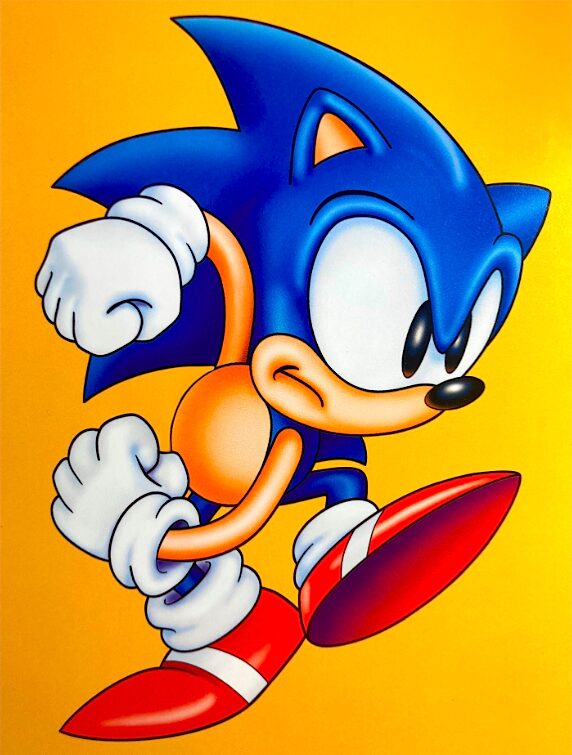Case Study 2
Sonic The Hedgehog
Videogame Superstar & Media Phenomenon
Overview In Brief
In the early 1990s Sega’s flagship videogame character, Sonic The Hedgehog™ quickly won the hearts of gamers worldwide—and continues to be one of the best-selling videogame series and licensed properties of all time, more than three decades later.
Sonic’s spin, packaging design for Sonic licensee, Campbell’s Soup/Franco-American Spaghetti, Macy’s Thanksgiving Parade Balloon & classic Sonic pose.
The Challenge
Rather than its taller, gangly counterpart, the original, Japanese Sonic The Hedgehog animated character, Sega Of America wanted its version of Sonic to be shorter, cuter and rounder. Working closely with the Sega Of America Design Team, we restyled Sonic for the US and international markets, documenting the character’s Do’s & Don’ts by writing, designing and illustrating the first, official Sonic The Hedgehog Style Guide.
Outcome & Results
Our Sonic Style Guide served as the roadmap for Sega’s licensees and strategic partners in the proper use and portrayal of this character across a wide spectrum of licensed categories, products and co-branding promotions. As an official “Preferred Vendor” to Sega, we illustrated and designed Sonic The Hedgehog product packaging and promotional art for brand leaders including Coca-Cola, Campbell’s Soup, Mattel, Milton-Bradley, Nikko Japan, Western Publishing/Golden Books and Thermos, among many more.
Our illustration of Sonic The Hedgehog’s signature penchant for speed, and billboards taking over Times Square for Sonic’s epic, 2021 movie premier.
Our work with Sega of America contributed to the following Sonic The Hedgehog brand highlights:
• In addition to becoming a cultural icon, the Sonic The Hedgehog brand remains an enduring, financial success—with nearly $12 billion in total revenues to date.
• Sonic’s licensing program has generated nearly $3 billion of revenues to date and continues to help drive global sales of the Sonic The Hedgehog videogame franchise—with combined game unit sales and downloads of 1.6 billion and counting.
• Notably, shortly after the brand’s US introduction in 1992, more children ages 6-12 knew who Sonic The Hedgehog was than Disney’s iconic signature character, Mickey Mouse.
Now, over three decades and a hit movie later, as the brand and character continue to evolve, Sega’s Sonic The Hedgehog franchise remains very much alive and well.
The Important Difference Between Brand Consistency & Brand Evolution
One of THE most important tenets of branding is to maintain consistency in every conceivable respect—from logo fonts, color palette, and brand messaging to stylistic character traits—and every other aspect of a brand’s image and core principles.
Yet, there are obvious, stylistic differences between our original Sonic The Hedgehog character styling, and how this brand has evolved to date. Why is it important to understand the difference? Evolutionary differences should NOT be confused with a lack of brand consistency. Every animated character of any consequence has evolved over time. One needs only to look no further than Disney’s signature character, Mickey Mouse to see stark differences between the original 1928 character and what we currently see of Mickey in print, animation, toys, and at Disney theme parks.
Similarly, Sonic the Hedgehog has evolved because this animated character and licensed property’s owners felt the need to re-invent ‘him’ over time, in order to compete with other characters that are popular with the age range of Sonic’s fan base.
The ALL-important difference between a brand’s natural evolution and brand consistency is simple. For the duration of a given time period such as a multi-season TV series, or the period during which an e-game or board game series is popular, conventional brand wisdom dictates that customer expectations of brand consistency be strictly observed. HOWEVER, toward the development of the next (and subsequent) iteration(s) of an animated character in a TV or game series or other forms including toys, plush, etc., savvy brand managers are constantly gauging their brand against its competition—tweaking its stylistic traits, and even its core values accordingly—to reflect ever-evolving, increasingly fickle public tastes and trends.







